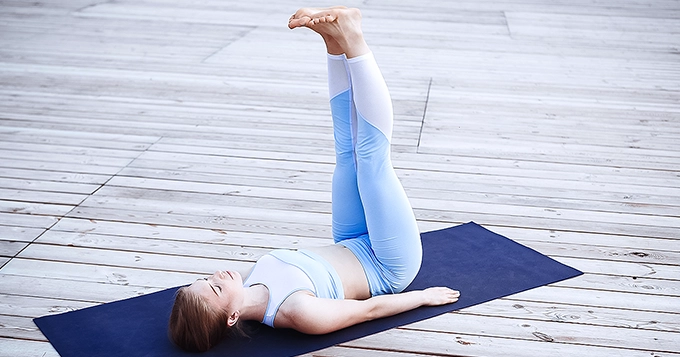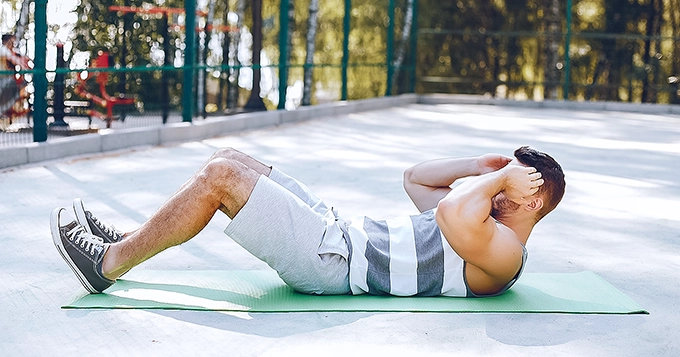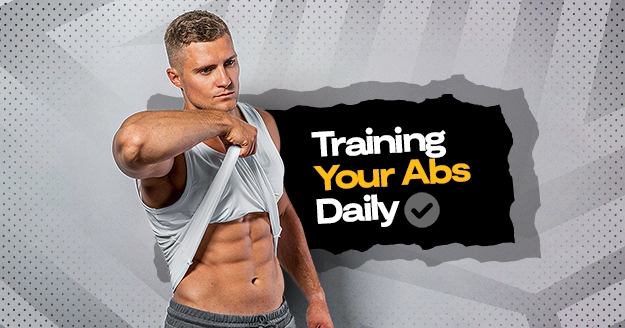Are you someone who dreams of having a strong and defined core by doing some of the best ab workouts? You’re not alone. Many people strive for those washboard abs or a strong, stable midsection. But the question arises: Should you train your core every day for the best outcomes?
Let’s investigate this topic and uncover the truth behind everyday ab training.
The Importance of Core Strength
Firstly, why is core strength so important?
Our core muscles act as the solid center of a chain, connecting your upper and lower body. Whether you’re swinging a racket or scrubbing the floor, these movements either start from your core or pass through it.
No matter where motion begins, it travels up and down to neighboring links in the chain. Weak or stiff core muscles can hinder the performance of your arms and legs, draining power from your movements. Strengthening your core boosts that power and improves balance and stability, reducing your risk of falls and injuries during various activities. A robust and flexible core supports almost every aspect of your life:
- Balance and stability
Your core provides stability, allowing you to move in any direction or maintain balance on uneven surfaces. Strengthening your core can reduce the risk of falls.
- Enjoyable activities
Many sports and recreational activities, such as golf, tennis, biking, or swimming, rely on a strong core for power and stability. Even activities like gardening or household chores involve movements that originate from or pass through the core.
- Everyday actions
Tasks like bending to tie your shoes, turning to check behind you, or standing up straight rely on your core strength, which you might not notice until they become difficult or painful. Even routine activities such as bathing or getting dressed call upon your core.
- Maintaining back health
Exercises that strengthen and balance core muscles can help prevent low back pain, a common issue affecting many people. Core exercises and other treatments like physical therapy or medication are often recommended to alleviate back pain.
- Maintaining good posture
Weak core muscles can lead to poor posture, while strong core muscles promote an upright stance. Good posture enhances your appearance and reduces strain on the spine and enables deep breathing, maximizing the benefits of exercise.
- Work responsibilities
Jobs that involve lifting, twisting, or prolonged standing engage core muscles. But even sitting at a desk for long periods requires core stability. Tasks like answering phone calls or using a computer can strain back muscles, particularly if your core isn’t strong enough to maintain good posture.
Should You Do Abs Everyday?
Now, let’s address the idea of training your core every day.
Pros of doing ab exercises daily:
- Increased Frequency of Training
Training your abs every day ensures that you’re consistently targeting and engaging the core muscles, which can lead to improvements in strength and endurance over time.
- Enhanced Muscle Engagement
Daily ab workouts can help improve mind-muscle connection and increase awareness of your core muscles, leading to better control and activation during exercises.
- Improved Muscle Tone
By consistently challenging your abdominal muscles, you may experience improvements in muscle tone and definition, resulting in a more sculpted midsection.
- Convenience and Efficiency
Daily ab workouts can be quick and convenient, requiring minimal equipment and space. They can easily be incorporated into your daily fitness routine, making staying consistent with your fitness goals easier.
- Better Balance
Your balance could improve when you do great ab workouts daily, as a strong core contributes to overall stability and coordination.
Cons of doing ab exercises daily:
- Risk of Overtraining
Training your abs every day without adequate rest can lead to overtraining, which can result in muscle fatigue, decreased performance, and increased risk of injury.
- Muscular Imbalances
Focusing exclusively on the abs while neglecting other muscle groups can lead to muscular imbalances, which may affect posture and overall movement patterns.
- Plateauing Progress
Without proper variation and progression, daily ab workouts may lead to plateauing progress, as the muscles adapt to the same routine and stimulus over time.
- Spine Health Concerns
Depending on the ab exercises you’re doing daily, you could be hurting your spine if proper form and technique are not maintained, leading to potential long-term issues. - Risk of Neck Injury
Daily ab exercises could lead to a neck injury if performed incorrectly or with excessive strain on the neck muscles.
Can you overwork your abs?
The short answer is yes. Your abdominal muscles operate similarly to other muscles in your body. Overworking any muscle group increases the risk of injury and can lead to muscle breakdown rather than growth.
Finding a Balance
So, what’s the verdict? Should you do abs everyday?
The answer isn’t black and white. While some individuals may benefit from daily core workouts, others may find that alternating days or incorporating core exercises into their regular routine yields better results.
Find a balance that works for you. Listen to your body, recognize signs of fatigue or overtraining, and adjust your workout frequency accordingly. Proper form, consistency, and progressive overload are essential to yield optimal results in any fitness endeavor.
When is the Best Time to Do Ab Workouts?
Morning
Pros:
- Boosts metabolism: Morning exercise can kickstart your metabolism, burning more calories throughout the day.
- Sets a positive tone: Starting your day with exercise can set a good tone for the rest of your day, leading to better productivity and mood.
- Consistency: Morning workouts may be easier to stick to since they are less likely to be disrupted by other commitments.
Cons:
- Stiffness: Your body may feel stiffer in the morning, which could affect your performance and flexibility during ab workouts.
Afternoon:
Pros:
- Increased energy: By the afternoon, your body temperature and energy levels tend to be higher, allowing for a more productive workout.
- Stress relief: Midday workouts can help alleviate stress and tension accumulated throughout the day, leaving you feeling refreshed and rejuvenated.
Cons:
- Time constraints: Afternoon workouts may be challenging to fit into a busy schedule, especially if work or other commitments take precedence.
Evening:
Pros:
- Stress relief: Great ab workouts at night can serve as a stress-relieving activity after a long day, helping you unwind and relax.
- Performance peak: Your body’s core temperature is typically at its highest in the evening, which may enhance workout performance.
Cons:
- Disruption to sleep: Intense exercise close to bedtime can disrupt sleep patterns for some individuals, making it harder to fall asleep or stay asleep.
Verdict
All “pros” and “cons” aside, any ab workout is better than no workout.
Ultimately, the best time to do ab workouts is whenever you can consistently commit to them and perform at your best. Whether it’s in the morning, afternoon, or evening, prioritize consistency and listen to your body.
Experiment by doing ab exercises at different times of the day to see what works for your energy levels, schedule, and overall well-being. Remember, the most important thing is to stay active and keep challenging your core muscles to achieve your fitness goals.
What are the Best Ab Workouts?
The best way to get abs aside from proper diet and rest is by incorporating few of these exercises in your fitness routine:
Plank
A classic core exercise is the best way to get abs since it targets the entire core, including the rectus abdominis, transverse abdominis, and obliques. Start in a push-up position with your elbows bent and forearms resting on the ground. Keep a straight line from your head to your heels, engaging your core muscles. Hold this position as long as you can.
Crunches
A fundamental ab exercise that targets the rectus abdominis. Lie on your back with your knees bent and feet flat on the floor. Put your hands crossed over your chest or behind your head. Lift your upper body off the floor by tightening your abs, then slowly lower back down.
Russian Twists
Russian twists focus on the lower abdominal muscles. Start by lying on your back. Extend your legs and position your hands beneath your lower back to provide support. Elevate your legs off the floor while maintaining their straight position, then gradually lower them towards the ground without allowing them to touch it. Concentrate on activating your core muscles to avoid excessive lower back arching.
Leg Raises
Leg raises target the lower abs. Begin by lying on your back. Extend your legs and position your hands beneath your lower back to offer stability. Elevate your legs off the floor while ensuring they remain straight, then gradually lower them back down, maintaining a controlled motion without allowing them to make contact with the ground. Pay close attention to engaging your core muscles to avoid excessive arching in your lower back.
Mountain Climbers
This dynamic exercise activates the entire core and offers a cardiovascular challenge. Begin in a push-up position with your hands shoulder-width apart. Bring one knee toward your chest, then swiftly alternate legs, mimicking a running motion while maintaining a tight core and a flat back.
Dead Bug
This exercise focuses on the deep core muscles and enhances stability. Begin by lying on your back with your arms stretched toward the ceiling and your legs raised in a tabletop position. Gradually lower one arm and the opposite leg toward the ground while ensuring your lower back remains pressed into the floor, then return to the initial position and alternate sides.










